Ryogoku Kokugikan and Grand Sumo 両国国技館
|
Title   • File Name • File Name   • Date • Date   • Position • Position   |
|

The Kokugikan as seen from JR Ryogoku Station platform.
|
|

Way to Kokugikan. The guarded side gate on the right is for sumo wrestlers.
|
|

Taiko drum tower
|
|
|

Sumo wrestler and sumo stable banners
|
|

Kokugikan
|
|

Kokugikan ticket office (right). Ticket prices range from 2,100 yen to 14,300 yen.
|
|

Kokugikan ticket office. Cheap tickets costing 2,100 yen are sold every day of the tournament, but sell out fast by noon or so.
|
|

At the gate, you might see a famous former wrestler (like former Takamiyama from Hawaii, now Stablemaster Azumazeki) taking your ticket.
|
|

Front of Kokugikan. The wide stairs make it quick for many people to exit the building. It is a sleek, modern building with a spacious interior. The roof collects rainwater for use in the toilets.
|
|
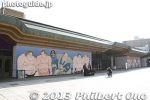
After you go through the ticket gate, the front of Kokugikan has two large murals.
|
|
|
|
|
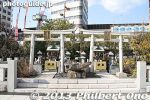
Two small shrines outside.
|
|
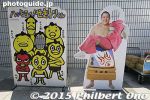
Pose with a cutout of popular rikishi Endo.
|
|
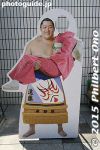
Pose with a cutout of popular rikishi Endo.
|
|

Sumo wrestlers enter through a side entrance. Fans wait for their favorite wrestlers.
|
|

Entrance lobby. At the end of the lobby is a trophy showcase. On the last day of the tournament, the tournament winner will walk through here to his car for a victory parade amid a large crowd.
|
|

Sumo mural in lobby.
|
|
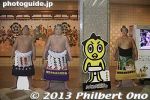
In the entrance hall are life-size cutouts of the top wrestlers.
|
|

Trophy case in lobby. This is the Emperor's Cup awarded to the tournament winner.
|
|

Nameplates of tournament winners on Emperor's Cup
|
|
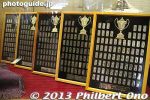
Old Nameplates of tournament winners that were on the Emperor's Cup.
|
|
|
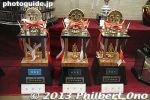
Trophies for the Three Outstanding Prizes (Technique, Outstanding Performance, and Fighting Spirit) from the Japan Sumo Association.Technique Prize (Gino-sho), Outstanding Performance (for most Yokozuna/Ozeki upsets, Shukun-sho), and Fighting Spirit (Kanto-sho).
|
|

The tournament winner receives numerous prizes from various organizations and companies.
|
|
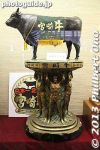
Prize from Miyazaki Prefecture.
|
|
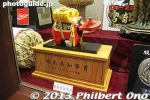
Prize from Fukushima Prefecture.
|
|
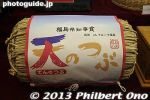
Another prize from Fukushima Prefecture.
|
|

Prime Minister's Cup on left, the middle is the President Chirac Award from France, and the glass on the right is a prize from the Czech Republic.President Chirac is a sumo fan. There is also a Czech wrestler in the lower division.
|
|

Prize from the United Arab Emirates.
|
|

In the back on the left is a prize from Mexico and one from Hungary on the right. In the front on the left is a prize from Mongolia, middle is from NHK, and right is from China.
|
|

Sumo museum
|
|

Sumo Museum. Open only during tournament days. Free admission.The wall on the left show portraits of all the yokozuna in the modern era.
|
|
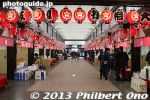
Sumo service entrance for groups.
|
|

Corridor and souvenir shops.A corridor encircles the arena.
|
|
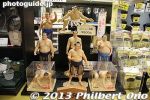
Sumo figurines.
|
|
|
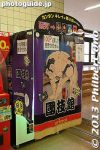
Print Club photo sticker booth.
|
|

Entrance to the dining room for chanko-nabe. It's downstairs in the basement.
|
|

The chanko-nabe menu changes a few times during the tournament. The recipes are from various sumo stables.
|
|
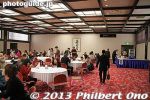
The banquet hall in the basement is used as a dining room during lunch time during tournaments. 大広間
|
|

It is really good! Different flavors are offered during different days of the tournament. Top is shoyu (soy sauce) flavor, and bottom is salt flavor. Miso flavor is also offered.
|
|

Lecture classroom (previously used as a dining room for chanko-nabe during tournaments). 相撲教習所
|
|

Next to the chanko dining room is a sumo ring for practice and deliberation exhibition matches.
|
|

The sign reads "Physical body, Technique, Heart." What you need to succeed in sumo.
|
|

Door to arena.
|
|
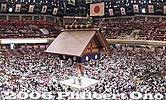
Panorama shot of sumo arena during a sumo tournament. There are two levels.
|
|

This is the lower level with zabuton box seats costing over 10,000 yen.
|
|

Box seats. Cramped space for four people.
|
|

Sumo ring and suspended roof (no pillars).
|
|

Shinto-style roof. If the house is full, the "Full House" banners are rolled down above the roof. (Now rolled up.)
|
|
|
|

Upper level and VIP booth.
|
|

VIP booth or "Royal Box" where the Emperor and Empress (or Crown Prince and Princess) or head of state watch sumo.
|
|

Upper level and giant sumo portraits of 32 past tournament winners. As of Jan. 2012, there are no portraits of Japanese sumo wrestlers. Only foreigners.
|
|

Giant portrait of Yokozuna AkebonoThese are B/W photographs painted over with oil.
|
|

Giant portrait of Yokozuna Takanohana
|
|
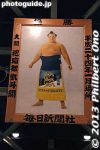
Giant portrait of Baruto
|
|
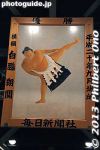
Giant portrait of Yokozuna Hakuho
|
|
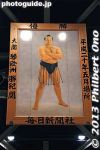
Giant portrait of Ozeki Kotooshu.
|
|

Sumo scoreboard. The names of all the wrestlers are displayed in the order of the sumo matches (from right to left). The winner is indicated with a red lamp. Names of sumo wrestlers absent from the tournament (due to injury, etc.) are listed on the far le
|
|

Grand sumo tournaments are held six times a year in Jan., March, May, July, Sept., and Nov. They are held at Ryogoku Kokugikan arena in Tokyo in Jan., May, and Sept. In March, it is in Osaka, July in Nagoya, and Nov. in Fukuoka. This is the Kokugikan.
|
|

Each tournament is 15 days long, and each wrestler in the top two divisions wrestle once a day. A wrestler must win at least 8 times during a tournament to get promoted. Otherwise, he is demoted in rank. The more he wins, the higher he is promoted.
|
|

There are about 800 sumo wrestlers, called rikishi, and they belong to one of six divisions. Each day of the tournament starts in the morning with the lower divisions as you see here. They are skinnier and wear drab-looking black mawashi.
|
|

The sumo matches have five judges (shinpan), dressed in formal black kimono, sitting on each of the four sides of the sumo ring. There is also a referee (gyoji) on the ring. This is former yokozuna Takanohana who has lost much weight and looks like a kid.
|
|

One colorful highlight each day during a tournament is the dohyo-iri ring-entering ceremony performed by rikishi in the top two divisions. These are rikishi in the second highest division called Juryo. 十両
|
|

The wrestlers are divided into east and west, and both groups perform the dohyo-iri. They wear colorful ceremonial aprons called kesho mawashi made of silk. They can cost up to 500,000 yen.
|
|

On the first day of the tournament, the chairman of the Japan Sumo Association (shown here is Kitanoumi) and top rikishi go on the ring to convey greetings to the crowd.
|
|

Next we have the ring-entering ceremony by the top division wrestlers in the Makunouchi Division. Rikishi from the east side come down the aisle first. They are led by a referee.
|
|

The colorful kesho mawashi are expensive to make, and each wrestler has a sponsor who donates an apron. The sponsor's name is usually on the bottom.
|
|

The sumo tournaments are broadcast live every day on TV by NHK, focusing on the Makunouchi Division matches.
|
|

After the last wrestler is on the ring, they all turn around and raise their arms.
|
|

Getting off the sumo ring.
|
|

Ozeki Kotooshu with an apron by Bulgaria Yogurt. (Kotooshu is from Bulgaria.)
|
|

Wrestlers wait until everyone is on the ring. Notice that Takamisakari (second from the left) and the rikishi on the far right have almost the same aprons. They will serve as the sword bearer and dew sweeper for the yokozuna ring-entering ceremony.
|
|

Hakuho, before he became yokozuna.
|
|

Baruto, from Estonia, at the center. He's well on his way to become Ozeki. There are many foreign sumo wrestlers. Unfortunately, there are none from Hawaii. Mostly Europeans and Mongolians.
|
|
|
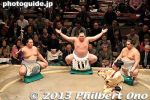
Yokozuna Hakuho
|
|
|
|
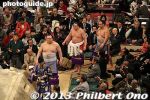
Next is Yokozuna Harumafuji.
|
|
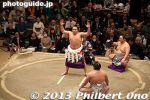
Yokozuna Harumafuji from Mongolia performs the dohyo-iri ring-entering ceremony.
|
|
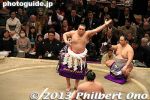
Yokozuna Harumafuji
|
|
|
|
|
|

The rikishi sits at ringside until his name is called by the yobidashi (caller or usher) here who is announcing the wrestler's name while holding a fan.
|
|

The two rikishi who were called up go on the ring and stomp their foot.
|
|

Then they rinse their mouths with water for purification. Another wrestler holds the water ladle and tissue paper.
|
|

Then they throw salt onto the ring for purification. They do this a few times before the match. These are all Shinto-based religious rituals. Even the roof above the sumo ring looks like a Shinto shrine roof.
|
|

Takamisakari does his "Robocop" act in his corner to psych himself up.
|
|

On the ring, they spread their arms to show that they carry no weapons.
|
|

Many matches also have sponsor who pay money to the winner of the match. Each banner represents a sponsor.
|
|

They glare at each other a few times before the match. They repeat the salt throwing and glaring for four minutes before the match starts.
|
|

The initial charge or tachiai is crucial, and can determine who will win the match. The rikishi on the right has charged earlier than the other, giving him the advantage.
|
|

Often the wrestlers will lock onto each other while gripping each other's mawashi belts (made of silk). (Ozeki Kaio vs. Tamanoshima in May 2005.)
|
|

There are many sumo techniques (called kimarite) to defeat the opponent. This is okuridashi or rear push out. Once your back is toward the opponent, you have little chance to recover.
|
|

Overarm throw called uwatenage.
|
|

Sometimes a match is too close to call. The ringside judges will hold a conference in the ring and either decide who was the winner or declare a rematch. The referee must accept the decision. Judges in the video room may also examine a replay on video.
|
|

Referees are also ranked. The higher ranking referees appear for the matches of the higher-ranking rikishi. They have different dress as the rank goes higher. The lowest-ranked referee may be barefoot.
|
|

Kotooshu is from Bulgaria.
|
|

The referee is thrown into the crowd by the wrestler (by accident, of course). An attendant carries the water bucket out of the way so the referee does not crash into it and spill the water. A judge looks on concerned, while some spectators are amused.
|
|

Kotooshu sits on his own cushion at ringside before his bout.
|
|

Besides Europeans, there are numerous Mongolians in sumo. This is Hakuho in May 2005. He's now a yokozuna.
|
|

Sumo scoreboard. The names of all the wrestlers are displayed in the order of the sumo matches (from right to left). The winner is indicated with a red lamp.
|
|

Asashoryu and Hakuho glare at each other.
|
|

If you want to photograph sumo, you'll need a good telephoto lens. The sumo ring has mostly tungsten lighting.
|
|
|
|

There goes Asashoryu.
|
|

The striking yokozuna upset makes the crowd go wild as they throw zabuton cushions in glee.
|
|

Hakuho collects his pay.
|
|

The thrown cushions are hastily piled up at ringside.
|
|
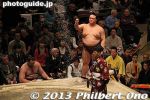
Ozeki Kisenosato
|
|
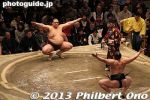
Ozeki Kisenosato vs. Yokozuna Harumafuji in Jan. 2013.
|
|
|
|
|
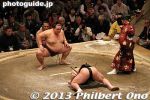
Harumafuji doing his very low stance.
|
|
|
|
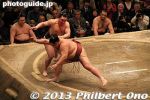
Harumafuji's common technique is to sidestep his opponent and push him out from behind.
|
|
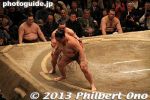
Kisenosato loses this one.
|
|
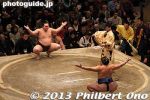
Yokozuna Hakuho vs. Ozeki Kakuryu in Jan 2013. They are both Mongolian.
|
|
|
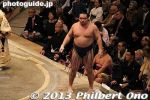
Ozeki Kakuryu in an 2013.
|
|
|
|
|
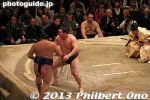
Hakuho beats Kakuryu.
|
|

Bow twirling (called Yumitori-shiki) is the final ceremony at the end of the tournament day which is around 6 pm.
|
|
|
|
|
|